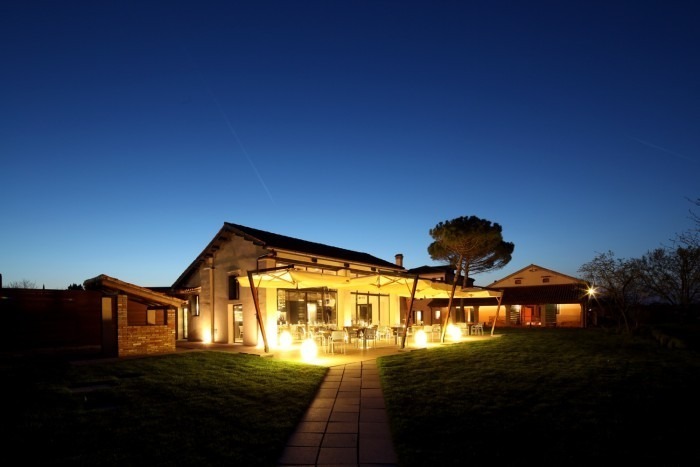Stay At The Venissa And Beat Venice's Tourist Traps
In Hungry Concierge, we travel the world to spot hotels that operate with their guests' food and drink needs squarely in mind — hotels, both big and small, that are located in neighborhoods rich with bar and restaurant options. Because there's nothing worse than having your trip derailed by crummy room service.
I used to hold a grudge against Venice.
I have a hard time figuring out when it started. I remember a family trip — I must have been seven or eight — when I managed to persuade my parents (with quite a great deal of whining) to buy me a huge pink-and-white toucan in Murano glass. And then I didn't like it anymore, and that beast looked down on me from the souvenir cabinet for the following ten years (one of my folks' sophisticated techniques in passive-aggressive parenting).
Then there was, in my early teens, a weekend with my aunt and uncle when I didn't feel well and proceeded to faint on the vaporetto (the steamboat serving as public transportation in the city), and what stayed with me the most was the crowd pressing on us, anywhere we went.
I didn't go back for almost ten years. When I eventually did, I realized — lo and behold! — that Venice is, simply put, one of the most beautiful places on Earth, and everyone should visit as often as possible.
But how do you avoid the crowds in one of the most popular destinations in the world? Here's the no. 1 trick up my Venetian sleeve: Most tourists spend the night in Venice and visit the islands of the Lagoon — the glass-making Murano, the enchanting Burano with its tiny rainbow-colored houses — during the day, via vaporetto. Hard to feel the magic when countless other tourists are intent on photobombing your precious memories, so do it the other way around: Stay on the islands and visit Venezia by day. You'll get the Laguna to yourself in the late afternoon, plus you get to stay at the amazing Venissa, on Mazzorbo island, connected to Burano by a charming wooden footbridge.

Venissa's Michelin-starred restaurant, Osteria Contemporanea, draws inspiration from local lagoon cuisine and traditional recipes, with a creative twist. Most produce used in the kitchen comes straight from the vegetable gardens and orchards located inside the walls of the estate, looked after by an energetic bunch of Burano elderlies. And there's all the bounty from the lagoon, perfectly showcased in dishes such as Ruote Pazze ("crazy wheels"), pasta cooked in a seafood broth, each painstakingly filled with small scallops, sea truffles, mussels and clams.
The sun-filled patio is the perfect backdrop for Venissa's scrumptious breakfast: freshly baked breads and pastries, cheese and cured meats, eggs — even a delicious tiramisu.

The Rooms
There are only six rooms in the beautiful, rustic building in the heart of the Laguna: the four rooms on the first floor overlook the lagoon and the Venissa vineyard, where the roots of the vines delve deep into the soil, holding on for dear life in the face of the near-constant threat posed by high tides of salt water. On the top floor, there are two ample and spacious suites under the roof with its exposed beams. The spacious, tastefully decorated rooms are almost austere: Luxury is in the details, such as the pristine linen sheets and towels. Thirteen more suites will open at the end of 2015, located among the brightly colored houses of Burano.

The Look
The Venissa Estate is situated on the island of Mazzorbo, which together with Torcello and Burano is part of native Venice. Venissa is one of the last examples of a "walled vineyard." And, in fact, the entire estate, with its cultivated area of over two hectares, is entirely encircled by medieval walls restored in 1727, as indicated by the marble markers set into the two sidewalls of the estate.
The Neighborhood
Less than half an hour by vaporetto separates the almost zen-like calm of Venissa from bustling Venice. While not all venues in the city are worth a visit, don't believe anyone who's ever told you that all restaurants in Venice are tourist traps. Stop for lunch at the one good restaurant in the Piazza San Marco: the amazing Caffè Quadri. The Alajmo brothers — whose Le Calandre in Rubano, close to Padova, has three Michelin stars — bought this historical cafè overlooking the Piazza in 2011. They installed in its grand rooms a restaurant that is just as refined — if somewhat more approachable — than their flagship locale. Or head out to Vino Vero (meaning "real wine") and order a glass of Malvasia Istriana while taking in the sight of the canals, while listening to the melodious chitchat of locals freshly out of Sunday Mass, their thick Venetian accent, the slippery "r" that is wholly peculiar to the city.
A holiday in Venice would not be complete without a bacari tour. A bacaro (singular; "bacari" is the plural) is the love child of a bar and an osteria, combining bar ambience with osteria food. A bacaro serves cicchetti — small snacks not unlike Spanish tapas, a comparison the locals strongly dislike (don't get caught making it!). A cicchetto has to be washed down with an ombra, literally a "shadow" of wine — essentially, a small pour. What I love about Venice is that, with the exception of tourist traps, prosecco here is considered more a basic human right than a luxury good, so a lovely wine-filled lunch of polpette (meatballs) and baccalà mantecato (whipped salt cod) will be among the best value for money you're bound to find in Venice. Two very popular options are All'Arco and Al Mercà, both very close to the Rialto bridge.
Fondamenta Santa Caterina, 3 Island of Mazzorbo, Venice
Rooms from $155

